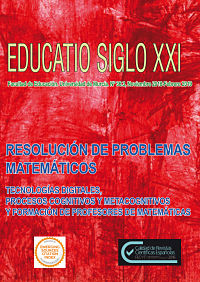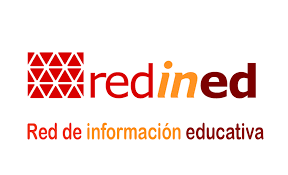El rol de la tecnología en el desarrollo de entendimiento matemático vía la resolución de problemas
Resumen
El uso de tecnologías digitales ha llevado a incorporar nuevos elementos de reflexión para abordar el problema de aprendizaje matemático, ya que al resolver problemas con tecnologías digitales aparecen elementos que en un ambiente de papel y lápiz pueden quedar ocultos. Por ejemplo, al describir el cambio de volumen al variar la altura de un líquido en un recipiente, el estudiante debe imaginar cómo se da ese cambio. Sin embargo, con el uso de la tecnología, puede visualizar tal cambio y concentrar la atención en otros aspectos, tales como la razón de cambio o la convidad de la gráfica. En este trabajo presentamos resultados de un estudio que involucró el uso de GeoGebra para desarrollar tareas de instrucción enfocadas a explorar el entendimiento matemático de los estudiantes para formular relaciones funcionales y su implicación al elaborar gráficas de volumen vs altura. Las tareas se implementaron con estudiantes de primer semestre de una licenciatura en matemáticas, de una universidad pública en México. La información se analizó desde una perspectiva epistemológica socioconstructivista y una posición didáctica que privilegia el entendimiento
matemático, vía la resolución de problemas. Las unidades de análisis fueron las secuencias de razonamiento desarrolladas por los estudiantes. El uso sistemático de tecnología promovió la formación de estructuras conceptuales en procesos de razonamiento de tipo cualitativo y cuantitativo. También se identificaron algunas limitaciones de la herramienta para promover la organización de ideas, sobre todo aquellas que se refieren a la concavidad de las gráficas.
Descargas
-
Resumen1625
-
PDF1169
Citas
Barrera-Mora, F., & Reyes-Rodriguez, A. (2016). Designing technology-based tasks for enhancing mathematical understanding through problem solving. In L. Uden, D. Liberona and B. Feldmann (Eds.), Learning technology for education in cloud: The changing face of education (pp. 183-192). Switzerland: Springer.
Berger, W. (2014). A more beautiful question: The power of inquiry to spark breakthrough ideas. New York, NY: Bloomsbury.
Brown, C. & Borko, H. (1992). Becoming a mathematics teacher. In D. A. Grouws (Ed.), Handbook of research on mathematics teaching and learning (pp. 209-239). New York: Macmillan.
Carlson, M. P., Jacobs, S., Coe, E., Larsen, S., & Hsu, E. (2002). Applying covariational reasoning while modeling dynamic events: A framework and a study. Journal for Research in Mathematics Education, 33(5), 352–378.
Carlson, M. P., Larsen, S., & Lesh, R. A. (2003). Integrating a models and modeling perspective with existing research and practice. In R. A. Lesh and H. Doerr (Eds.), Beyond constructivism: Models and modeling perspectives on mathematics problem solving, learning and teaching (pp. 465-478). Mahwah, NJ: Lawrence Erlbaum Associates.
Chimhande, T., Naidoo, A., & Stols, G. (2017): An analysis of Grade 11 learners’ levels of understanding of functions in terms of APOS theory. Africa Education Review, 14(3-4), 1-19.
Cobb, P., Wood, T., Yackel, E., Nichols, J., Wheatley, G., Trigatti, B., & Perlwitz, M. (1991). Assessment of a problem-centered second grade mathematics project. Journal for Research in Mathematics Education, 22, 3-29.
de Beer, H., Gravemeijer, K., & van Eijck, M, (2015). Discrete and continuous reasoning about change in primary school classrooms. ZDM Mathematics Education, 47, 981-996.
de Beer, H., Gravemeijer, K., & van Eijck, M. (2017). A proposed local instruction theory for teaching instantaneous speed in grade five. The Mathematics Enthusiast, 14(1), Article 24. Recuperado el 16 de marzo de 2017 de http://scholarworks.umt.edu/tme/vol14/iss1/24
De Faria-Campos, E. (2004). Funciones embotelladas. En L. Díaz (Ed.), Acta Latinoamericana de Matemática Educativa (pp. 584-589). México: Comité Latinoamericano de Matemática Educativa.
Donald, M. (1993). Origins of the modern mind. Cambridge, Massachusetts: Harvard University Press.
Drijvers, P. (2015). Digital technology in mathematics education: Why it works (or doesn’t). In S. J. Cho (Ed.), Selected regular lectures from the 12th International Congress on Mathematical Education (pp. 135-151). Cham: Springer.
Glaister, E. & Glaister, P. (2006). Introducing conics without eccentricity. International Journal of Mathematical Education in Science and Technology, 37(2), 235-245.
Heid, M. K., Lunt, J., Portnoy, N., & Zembat, I. O. (2006). Ways in which prospective secondary mathematics teachers deal with mathematical complexity. In S. Alatorre, J. L. Cortina, M. Sáiz & A. Méndez (Eds.), Proceedings of the 28th annual meeting of the North American Chapter of the International Group for the Psychology of Mathematics Education (Vol. 2, pp. 2-9). Mérida, Mexico: PME-NA.
Hitt-Espinosa, F. (1995). Intuición primera versus pensamiento analítico: dificultades en el paso de una representación gráfica a un contexto real y viceversa. Educación Matemática, 7(1), 63-75.
Johnson, H. L. (2012). Reasoning about quantities involved in rate of change as varying simultaneously and independently. In R. Mayes & L. L. Hatfield (Eds.), Quantitative reasoning and mathematical modeling: A driver for STEM integrated education and teaching in context (Vol. 2, pp. 39-53). Laramie, WY: University of Wyoming College of Education.
Johnson, H. L. (2013). Designing Covariation Tasks to Support Students’ Reasoning about Quantities involved in Rate of Change. STEM Faculty Presentations. Paper 45. Recuperado el 16 de marzo de 2016 de http://source.ucdenver.edu/stem_presentations/45
Kaput, J. J., & Schorr, R. Y. (2008). Changing representational infrastructures changes most everything. In G. W. Blume & M. K. Heid (Eds.), Research on technology and the teaching and learning of mathematics: Cases and Perspectives (Vol. 2, pp. 211-253). Charlotte, NC: Information Age Publishing.
Kindle, J. H. (1970). Teoría y problemas de geometría analítica plana y del espacio (Trad. Luis Gutiérrez Díez y Ángel Gutiérrez Vázquez). México: McGraw-Hill.
Koehler, M. J. & P. Mishra (2009). What is technological pedagogical content knowledge? Contemporary Issues in Technology and Teacher Education, 9(1), pp.60-70.
Lehmann, C. (1990). Geometría Analítica (Díaz, R. Trad.). México: Limusa. (Primera edición 1942).
Lithner, J. (2008). A research framework for creative and imitative reasoning. Educational Studies in Mathematics, 67(3), 255-276.
Mishra, P. & Koehler, M. (2006). Technological Pedagogical Content Knowledge: A new framework for teacher knowledge. Teachers College Record, 108 (6), 1017-1054.
Moreno-Armella, L. (1996). Mathematics: a historical and didactic perspective. International Journal of Mathematical Education in Science and Technology, 27(5), 633-639.
Moreno-Armella, L. (2002). Fundamentación cognitiva del currículo matemático. En Ministerio de Educación Nacional (Ed.), Memorias del Seminario Nacional Formación de Docentes sobre el Uso de Nuevas Tecnologías en el Aula de Matemáticas (pp. 40-66). Bogotá, Colombia: Ministerio de Educación Nacional.
Moreno-Armella, L., & Santos-Trigo, M. (2008). Democratic access and use of powerful mathematics in an emerging country. In L. D. English (Ed.), Handbook of International Research in Mathematics Education, 2nd Edition (pp. 319-351). New York: Taylor & Francis.
Moreno-Armella, L., & Santos-Trigo, M. (2015). The use of digital technology in mathematical practices. In L. D. English and D. Kirshner (Eds.), Handbook of International Research in Mathematics Education, 3rd Edition (pp. 595-616). New York: Roudledge.
Moreno-Armella, L., Hegedus, S. J., & Kaput, J. J. (2008). From static to dynamic mathematics: historical and representational perspectives. Educational Studies in Mathematics, 68, 99-111.
National Council of Teachers of Mathematics (NCTM) (2010) Mathematics Curriculum. Issues, Trends, and Future Directions, edited by Reys, B.J., Reys, R.E. and Rubenstein, R., The Council, Reston, VA.
Pea, R. D. (1987). Cognitive technologies for mathematics education. En A. Schoenfeld (Ed.), Cognitive Science and Mathematics Education (pp. 89-122). Hillsdale: Erlbaum.
Reyes-Rodríguez, A., Vargas-Alejo, V., Cristobal-Escalante, C., y Soberanis-Cruz, V. (2015). Formas de razonamiento que emergen al resolver problemas de máximos y mínimos con un SGD. Epsilon. Revista de Educación Matemática, 91, 7-24.
Santos-Trigo, M. (2007). La resolución de problemas matemáticos: fundamentos cognitivos. Mexico: Trillas.
Santos-Trigo, M. (2014). Problem solving in mathematics education. In S. Lerman (ed.), Encyclopedia of Mathematics Education (pp. 496-501). New York: Springer.
Santos-Trigo, M. (2015). La construcción de modelos dinámicos en el estudio de fenómenos de cambio o variación y la resolución de problemas. En C. Azcárate, M. Camacho-Machín, M. T. González y M. Moreno (Coords.), Didáctica del Análisis Matemático: una revisión de las investigaciones sobre su enseñanza y aprendizaje en el contexto de la SEIEM (pp. 163-177). La Laguna: Universidad de la Laguna.
Santos-Trigo, M. (2018). Problematizar los contenidos y la tecnología digital. C2 Ciencia y cultura. Recuperado de http://www.revistac2.com/problematizar-los-contenidos/ el 26 de julio de 2018.
Santos-Trigo, M. & Moreno-Armella, L (2016). The Use of Digital Technology to Frame and Foster Learners' Problem-Solving Experiences. In P. Felmer, E. Pehkonen & J. Kilpatrick (Eds.), Posing and Solving Mathematical Problems. Advances and new perspectives (pp. 189-207). Switzerland: Springer.
Sarama, J., & Clements, D.H. (2009). Early childhood mathematics education research: Learning trajectories for young children. New York: Routledge.
Schoenfeld, A. H. (1992). Learning to think mathematically: Problem solving, metacognition, and sense-making in mathematics. In D. Grouws (Ed.), Handbook for Research on Mathematics Teaching and Learning (pp. 334-370). New York: MacMillan.
Shell Centre for Mathematical Education [SCME] (1985). The language of functions and graphs: An examination module for secondary schools. Manchester, U.K.: Joint Matriculation Board.
Shulman, L. (1986). Those who understand: Knowledge growth in teaching. Educational Researcher, 15(2), 4-14.
Simon, M. A. (1994). Learning mathematics and learning to teach: Learning cycles in mathematics teacher education. Educational studies in mathematics, 26(1), 71-94.
Stein, M. K. & Smith M. S. (1998). Mathematical tasks as a framework for reflection: From research to practice. Mathematics Teaching in the Middle School, 3, 268-275.
Tabach, M. (2011). A mathematics teacher’s practice in a technological environment: A case study analysis using two complementary theories. Technology, Knowledge and Learning, 16(3), pp. 247-265.
Thompson, P. W., Byerley, C., & Hatfield, N. (2013). A conceptual approach to calculus made possible by technology. Computers in the School, 30, 124-147.
Vygotsky, L. S. (1962). Thought and language. Cambridge, MA: MIT Press.
Vygotsky, L. S. (1978). Mind in society: The development of the higher psychological processes. Cambridge, MA: Harvard University Press.
Wertsch, J. V. (1993). Voices of the Mind: A Sociocultural Approach to Mediated Action. Cambridge, Massachusetts: Harvard University Press.
Las obras que se publican en esta revista están sujetas a los siguientes términos:
1. El Servicio de Publicaciones de la Universidad de Murcia (la editorial) conserva los derechos patrimoniales (copyright) de las obras publicadas, y favorece y permite la reutilización de las mismas bajo la licencia de uso indicada en el punto 2.
2. Las obras se publican en la edición electrónica de la revista bajo una licencia Creative Commons Reconocimiento-NoComercial-SinObraDerivada 4.0 Internacional (texto legal). Se pueden copiar, usar, difundir, transmitir y exponer públicamente, siempre que: i) se cite la autoría y la fuente original de su publicación (revista, editorial y URL de la obra); ii) no se usen para fines comerciales; iii) se mencione la existencia y especificaciones de esta licencia de uso.
3. Condiciones de auto-archivo. Se permite y se anima a los autores a difundir electrónicamente las versiones pre-print (versión antes de ser evaluada) y/o post-print (versión evaluada y aceptada para su publicación) de sus obras antes de su publicación, ya que favorece su circulación y difusión más temprana y con ello un posible aumento en su citación y alcance entre la comunidad académica. Color RoMEO: verde.











